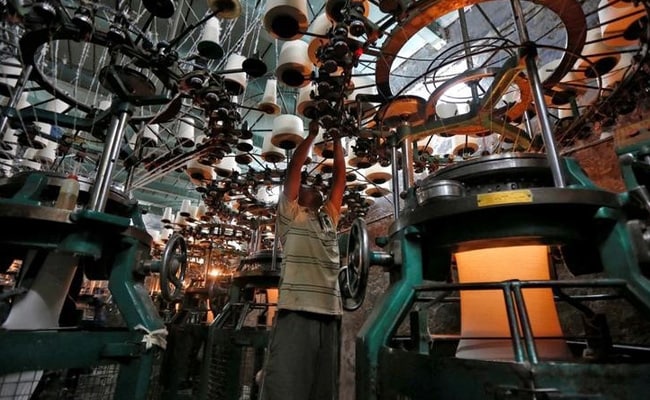
PM Narendra Modi's Economic Advisory Council will be headed by Bibek Debroy.
New Delhi:
Amid worries over an economic slowdown, Prime Minister Narendra Modi has set up a five-member panel of economists headed by NITI Aayog member Bibek Debroy to advise him.
The economic advisory council includes NITI Aayog's Principal Advisor Ratan Watal as its member and economists Surjit Bhalla, Rathin Roy and Ashima Goyal as part-time members. The panel will analyse issues, "economic or otherwise, referred to it by the Prime Minister", and will advise him on it, a government release said.
The council will "address issues of macroeconomic importance and present views thereon to the Prime Minister," the release said, adding that members of the panel can take these up on their own or by reference from the Prime Minister or anyone else.
PM Modi has set up the panel as his government grapples with a stuttering economy, with dismal growth figures in the last quarter prompting many private economists to revise down estimates for the fiscal year ending in March 2018.
 The spiral-down has also offered the opposition grist for its campaign against PM Modi ahead of key state elections and then the national election in 2019.
The spiral-down has also offered the opposition grist for its campaign against PM Modi ahead of key state elections and then the national election in 2019.
The government is concerned at the faltering growth despite a benign macroeconomic environment with easy money flowing in, global growth reviving, government revenues looking solid, deep foreign exchange reserves, reasonable oil prices and a decent monsoon keeping food prices in check.
Government data showed GDP growth in the first quarter of the current fiscal slumping to a three-year low of 5.7 per cent, from 7.9 per cent in the same quarter last year and 6.1 per cent in the last January-March quarter. GDP growth has declined steadily for six straight quarters.
Exports face strong headwinds and the current account deficit (CAD) in the April-June quarter rose to 2.4 per cent of the GDP, or US dollars 14.3 billion, mainly on account of an increased trade gap. CAD is the difference between inflow and outflow of foreign exchange. It was 0.1 per cent (USD 0.4 billion) in the June quarter last year and 0.6 per cent (USD 3.4 billion) in the January-March quarter this year.
 Although industrial output posted a modest recovery in July, 15 of 23 manufacturing industries recorded a contraction, adding to the concern.
Although industrial output posted a modest recovery in July, 15 of 23 manufacturing industries recorded a contraction, adding to the concern.
The ebb in the country's economic fortunes is in sharp contrast with a few quarters ago when it was the world's fastest growing major economy and was hailed as a rare bright spot in a dim global economy.
Since then economic growth has been on a downward trajectory, with the government struggling to fix debt-laden state-run banks and stressed corporate balance sheets.
Economists have also blamed teething troubles in the implementation of the Goods and Services Tax (GST) and a lingering impact of last year's notes ban for the slowdown.
The economic advisory council includes NITI Aayog's Principal Advisor Ratan Watal as its member and economists Surjit Bhalla, Rathin Roy and Ashima Goyal as part-time members. The panel will analyse issues, "economic or otherwise, referred to it by the Prime Minister", and will advise him on it, a government release said.
The council will "address issues of macroeconomic importance and present views thereon to the Prime Minister," the release said, adding that members of the panel can take these up on their own or by reference from the Prime Minister or anyone else.
PM Modi has set up the panel as his government grapples with a stuttering economy, with dismal growth figures in the last quarter prompting many private economists to revise down estimates for the fiscal year ending in March 2018.

PM Narendra Modi's has been grappling with worries of an economic slowdown (PTI).
The government is concerned at the faltering growth despite a benign macroeconomic environment with easy money flowing in, global growth reviving, government revenues looking solid, deep foreign exchange reserves, reasonable oil prices and a decent monsoon keeping food prices in check.
Government data showed GDP growth in the first quarter of the current fiscal slumping to a three-year low of 5.7 per cent, from 7.9 per cent in the same quarter last year and 6.1 per cent in the last January-March quarter. GDP growth has declined steadily for six straight quarters.
Exports face strong headwinds and the current account deficit (CAD) in the April-June quarter rose to 2.4 per cent of the GDP, or US dollars 14.3 billion, mainly on account of an increased trade gap. CAD is the difference between inflow and outflow of foreign exchange. It was 0.1 per cent (USD 0.4 billion) in the June quarter last year and 0.6 per cent (USD 3.4 billion) in the January-March quarter this year.

Indian's GDP growth rate stuttered its slowest in three years (Reuters).
The ebb in the country's economic fortunes is in sharp contrast with a few quarters ago when it was the world's fastest growing major economy and was hailed as a rare bright spot in a dim global economy.
Since then economic growth has been on a downward trajectory, with the government struggling to fix debt-laden state-run banks and stressed corporate balance sheets.
Economists have also blamed teething troubles in the implementation of the Goods and Services Tax (GST) and a lingering impact of last year's notes ban for the slowdown.
Track Latest News Live on NDTV.com and get news updates from India and around the world

